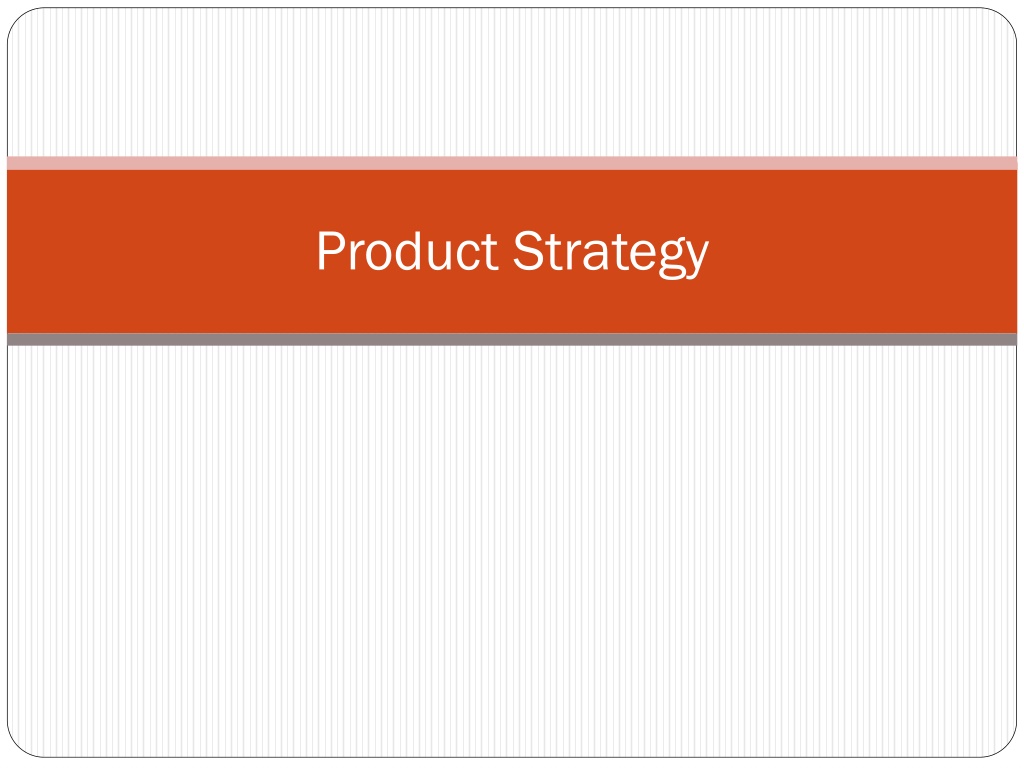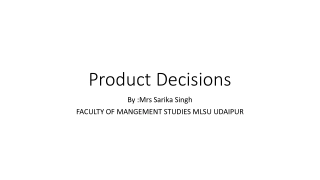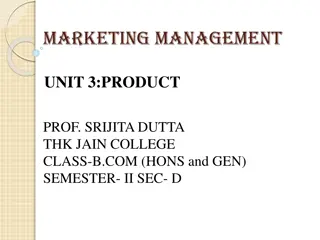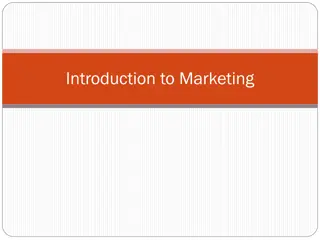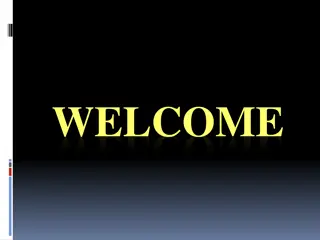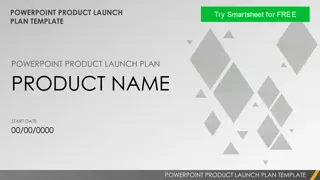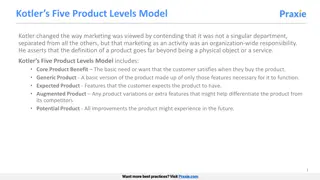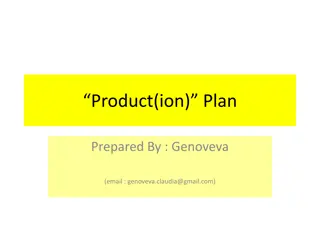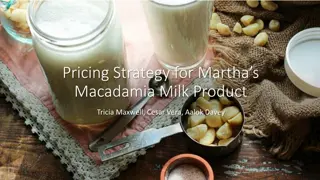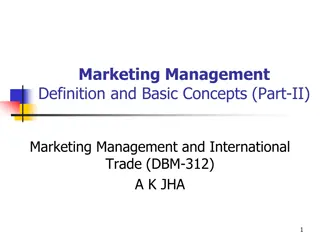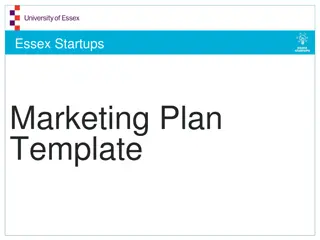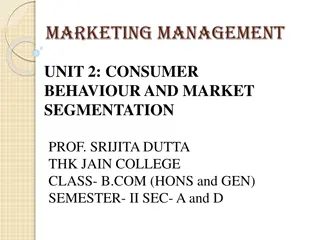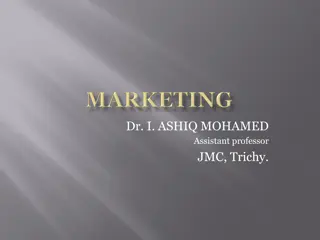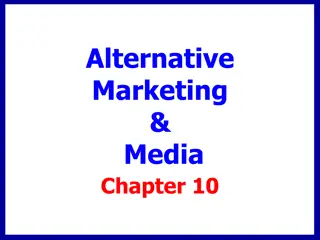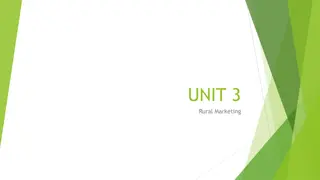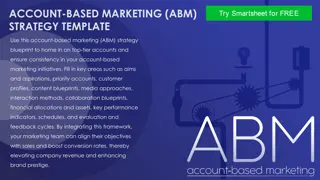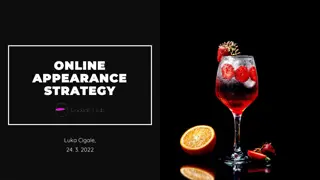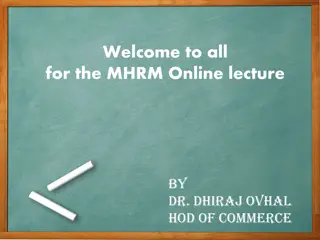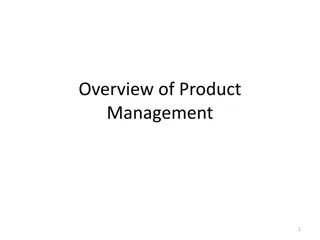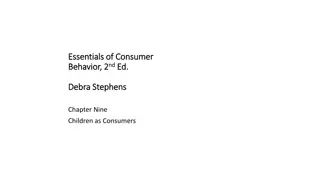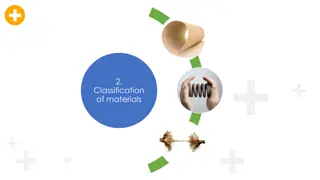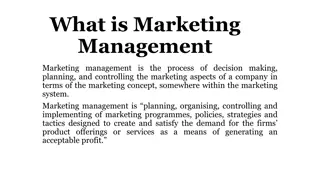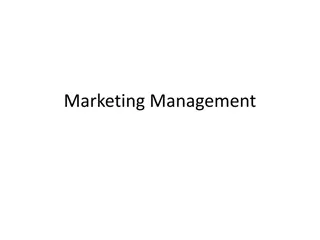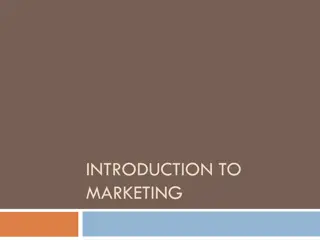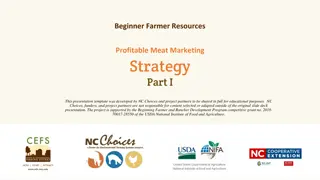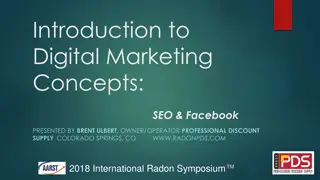Understanding Product Strategy and Classification in Marketing
Products play a crucial role in marketing, encompassing tangible, intangible, and augmented aspects to satisfy consumer needs. This comprehensive overview covers the levels of a product, core benefits, classifications (consumer and industrial), and the importance of aligning products with customer preferences. Additionally, it delves into how organizations market products, services, and ideas to influence consumer behavior effectively.
Download Presentation

Please find below an Image/Link to download the presentation.
The content on the website is provided AS IS for your information and personal use only. It may not be sold, licensed, or shared on other websites without obtaining consent from the author. Download presentation by click this link. If you encounter any issues during the download, it is possible that the publisher has removed the file from their server.
E N D
Presentation Transcript
What is a Product? Anything that can be offered to a market for attention, acquisition, use or consumption that might satisfy a want or need Any activity or benefit that one party can offer to another that is essentially intangible and does not result in the ownership of anything - Kotler
The CORE product is NOT the tangible physical product. This cannot be touched. Its the BENEFIT of the product that makes it valuable to you. E.g when purchasing a vehicle, the benefit is convenience i.e. the ease at which you can go where you like, when you want, etc. Another core benefit is speed since you can travel around relatively quickly. The ACTUAL product is the tangible, physical product. This can be touched. And you can get some use out of it. (It is the vehicle that you test drive and buy.. The AUGMENTED product is the non-physical part of the product. It usually consists of lots of added value, for which you may or may not pay a premium. (When purchasing a car, part of the augmented product would be the warranty, the customer service support offered by the car's manufacturer and any after-sales service). The augmented product is an important way to tailor the core or actual product to the needs of an individual customer. The features of augmented products can be converted in to benefits for individuals.
Consumer Products Consumer products- bought by final consumer for personal consumption Convenience products- products bought frequently, immediately and with minimum comparison and effort Shopping products- customer will compare based on suitability, quality, price & style Specialty products- products with unique characteristics & brand identification for which buyer will make a significant purchase effort Unsought products- product the consumer does not know about or knows but doesn t normally think of buying
Industrial Products Products bought by individuals and organizations for further processing of for use in conducting a business
Organizations, Persons, Places and Ideas Organization marketing consists of activities to create, maintain or change the behaviour and attitude of target consumers towards the organization People marketing consists of activities to create, maintain or change the behaviour and attitude towards people. Used by Doctors, lawyers, architects, etc (Oprah winfrey) Social marketing programs include public health campaigns to reduce smoking, drug abuse, alcoholism, etc
Individual Product & Service decisions Product/Servi ce attribute Product support services Branding Packaging Labeling
Product Line decision A group of products that are closely related because they function in a similar manner, are sold to the same customer groups, are marketed through the same types of outlets or fall within given price ranges.
Product Mix decision The set of all product lines and items that a particular seller offers for sale.
Service inseparability- a major characteristic of services. They are produced and consumed at the same time and cannot be separated from their providers Service variability- their quality may vary greatly depending on who provides them and when, where and how Service perishability- cannot be stored for later sale or use.
Marketing Strategies for Service firms The service profit chain Managing service differentiation Managing service quality Managing service productivity
Idea Generation New product development starts with idea generation The systematic search for new product ideas Internal sources: executives, manufacturing staff, sales people Eg :Samsung value innovation program where researcher, designers and engineers co-mingle to come up with new product ideas External sources: customer feedback, distributors, suppliers, competitors (the use of reverse engineering) LEGO invited 250 train set enthusiastic to asses new designs
Idea Screening Screening new product ideas to spot good ideas and drop poor ones as soon as possible. A company would access the product, the target market, competition, a rough estimation of the market size, product price, development time, costs, manufacturing costs Due to product development costs companies will only go ahead with product ideas that will be profitable.
Concept development & testing A detailed version of the new product idea stated in meaningful terms E.g: Daimlerchrysler developing their fuel- cell powered F-cell car. Concept testing involves testing the new product with a group of target customers to see if the concept has appeal Eg: Concept Board
Marketing strategy development Part 1 :The planned product positioning including sales, market share and profit goals for the year Eg: DaimlerCrysler, fuel-cell-powered electric car Target Market : Younger, well educated, moderate to high income individuals, couples or small families seeking practical environmental friendly transportation Positioning :Fun to drive less polluting than hybrid cars, less restricted than battery powered electric cars Sales & Profit: Aim to sell 100k at a loss not more than $15M in the first year ,120k and a profit of $25M in year 2.
Marketing strategy development Cont Part 2:An outline of the products' planned price, distribution and marketing budget Eg: DaimlerCrysler, fuel-cell-powered electric car Price : In 3 colors at $25,000 Distribution : 15% of the list price to the distributor, additional discount of 5% for more than 10 cars a months Ad Budget: $50M, spilt 50:50 on local and national advertising Part 3:Planned and long run sales, profit goals and marketing mix Eg: DaimlerCrysler, fuel-cell-powered electric car Long run sales & Profit : 3% share in the total auto market & 15% ROI after tax. Marketing mix: Improve quality, Increase price in year 2&3, 10% increase in Ad budget YOY.
Business analysis A review of the sales, costs, and profit projections for a new product to find out whether these factors satisfy the company s objectives product development stage To estimate sales the company might look at sales history of similar products and conduct surveys of market opinions
Product development Developing the product concept into a physical product E.g Gillette- the entire staff get involved in product testing. Requires a large investment . R&D develops a prototype A new product must have the required functional features and also convey the psychological characteristics Eg: DaimlerCrysler, fuel-cell-powered electric car should strike as being well built, comforatble and safe. For some consumer it may mean solid sounding doors
Test marketing The product and marketing program are tested in more realistic market settings The test market tests the entire marketing program- positioning, advertising, distribution, pricing, branding and packaging at budget levels The amount of test marketing varies depending on the product A new product that requires a big investment may involve a lot of test marketing Test marketing doest guarantee success
Commercialization The launch of the product into the market Company must decide where to launch; a single location, region, national market or international market The company must decide on introduction timing
Managing New-product development Customer centered new-product development: that focus on finding new ways to solve customer-satisfying experience Team based new product development: a approach in developing new products in which various company departments work closely together, overlapping the steps in the product development process to save and increase effectiveness Systematic new product development: new product development process should be systematic than haphazard. The company can install a innovation management system
Product life-cycle strategies Not all products follow the life cycle. Some products once introduced die quickly while others stay in the mature stage for a long time Some products are cycled back to the growth stage through strong repositioning and promotion (American Express/Gillette/Coca- cola)
Introduction stage Introduction takes time and sales growth is slow. Profits are negative or low because of the high distribution and promotion cost Focus is on buyers who are most ready to buy Much money is needed to attract distributors and build inventories Promotion spending is high to inform customers of the new product
Growth stage In this stage early adopters will continue to buy and late adopters will start to follow depending on the feedback New competition will enter the market attracted by profit potential The market tends to expand as competitors offer new features New market segments and distribution channels Face a trade-off between high market share and high profits
Maturity stage Lasts longer than the previous stages There s a slow down in sales as a result of many producers with many products. This leads to over capacity. Competitors begin price cutting Need to consider modifying the market, product and marketing mix Look to increase usage among existing customers
Decline stage Sales decline may be due to technological advances, shifts in consumer tastes, increased competition Firms may decide to drop the product altogether Carrying a weak product can be costly; loss making, management time, delay the search for replacements
